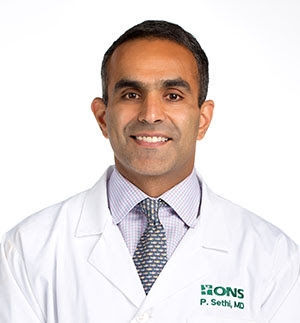
Q&A with Dr. Paul Sethi
Recent preliminary estimates from the Centers for Disease Control and Prevention (CDC) report that drug overdoses took the lives of more than 72,300 Americans last year, a rise of 10 percent from the year before.1 Further, experts say the opioid crisis in the U.S. can, in part, be attributed to overprescribing after surgery, and a recent study found that orthopedic patients are especially at risk for potential misuse following an operation.2 To turn the tide of overprescribing, orthopedic surgeons across the country have been making it a priority to use a multimodal approach to manage pain, a technique which leverages two or more different methods/medications (to treat pain) without solely relying on opioids.
Dr. Paul Sethi is a board-certified orthopedic surgeon who specializes in sports medicine conditions of the elbow, knee and shoulder at Orthopaedic & Neurosurgery Specialists in Greenwich, CT, and President of the ONS Foundation. Dr. Sethi’s experience in treating sports related pain ranges from weekend warriors to college and professional athletes. He previously served as an orthopedic consultant to the Los Angeles Dodgers baseball team and was the former assistant team physician for the Los Angeles Lakers basketball team, Los Angeles Kings hockey team and University of Southern California football team. His research interests with the ONS Foundation include a focus on opiate-avoidant surgery.
Dr. Sethi utilizes non-opioid, post-operative pain management options to help patients get back on their feet more quickly, and minimize, or in some cases eliminate, the need for opioids following surgery. In a recent conversation, he shared information on the effective non-opioid options available to manage pain following an orthopedic procedure and discussed the importance of developing a pain management game plan prior to surgery.
1. As an orthopedic sports medicine specialist, you have worked with many athletes with different conditions and injuries. Do you feel that athletes often put off surgery because they want to stay on the field, court, etc.?
Athletes do sometimes put off surgery because they’re fearful of the recovery time and missing practices, games, etc. I have treated college and professional athletes who try to play through their injuries – which can make the situation worse. I should emphasize though, it’s not just athletes. Many patients are concerned with the impact surgery will have on their normal routine and day-to-day activities, like taking time off from work or missing a vacation.
In my practice, I encourage a comprehensive, multimodal approach to post-operative pain management, including the use of non-opioids. Also, I go over key questions with each patient – which you can proactively bring up as well – such as:
- How will you help manage my post-operative pain?
- How long is the pain expected to last?
· What strategies will you be using to manage my pain during and after the procedure, including when I’m at home recovering?
2. How should athletes approach these concerns with their surgeon?
In my experience, athletes feel more at ease when we walk through exactly what to expect before, during and after their surgery. They want to know the entire game plan, including the pain management protocol I’ll be using. That is why I’m sure to go over those key questions with each patient, whether it’s a professional athlete or a patient who enjoys playing golf in their free time. Pain is different for everyone, and it’s important for all patients to have an open dialogue with their doctors about what to expect and which pain management strategy will best fit their needs.
3. So, knowing that a quicker recovery is important for athletes, how do you help your patients get back on their feet after surgery?
The key is to have an open and honest dialogue about a patient’s concerns about recovery with them and develop a post-operative pain management plan and ‘return to sport plan’ we both feel committed to. There are several options besides opioids for pain management, including anti-inflammatory medications that can be used during surgery and a longer-lasting anesthetic that can reduce pain for up to 72 hours after surgery. I have found that when utilizing these opioid alternatives, my patients recover faster, have less pain, experience fewer consequences and side effects, and avoid long-term exposure to opioids, if any.
In the past, patients had to spend days or even a week in the hospital following many common orthopedic procedures such as knee or shoulder replacement. Now, with advancements in postsurgical pain management, a patient can go home the same day as their surgery and expect the same safe outcome.
4. With legislation frequently being passed to limit opioid prescribing and help turn the tide of the epidemic, it’s no secret that the opioid crisis has affected physicians’ prescribing habits. How has the crisis affected pain management for orthopedic surgeons specifically?
Like many other areas of surgery, opioids have long been the first line of treatment for managing pain after orthopedic procedures. Doctors have historically been trained to treat pain as the fifth vital sign, unfortunately leading to overprescribing. We recognize that we need to hear patients when they talk to us about pain, but we also can’t turn a blind eye to the opioid epidemic that is ravaging the country. It’s a careful balance, but by utilizing the effective non-opioids that are available today, such as acetaminophen, ibuprofen and local anesthetics, we can provide patients with the same level of care without compromising patient satisfaction. For orthopedic procedures, physical therapy also plays a critical role in recovery for patients.
5. Has your approach to treating athletes and other orthopedic patients shifted at all?
I’m an orthopedic surgeon and my focus is on sports medicine and shoulder surgery. As such, I treat an opioid vulnerable group of patients. Athletes have a great deal of pressure to return to sport quickly. In recent years, we worked towards less invasive sports surgeries and taking on a multimodal approach, meaning we use two or more different methods or medications to manage pain after surgery. By taking a multimodal approach, some of my patients only receive a small opioid prescription following surgery, while other patients don’t require any additional pain medication at all. There are ways to limit opioid exposure while still offering optimal pain management and, in my practice, we make a concerted effort to do just that.
In our practice, patients are receiving one-half to one-third of the opioid pills for a given procedure compared to 5 years ago. Many patients will avoid opioids entirely with hip, knee and shoulder replacement, as well as ACL and shoulder labrum surgery. This is revolutionary.
6. Have you found that patients are open to non-opioid options?
Patients are very receptive and thrilled when I talk about opioid-avoidant surgery. Pain is scary, but so is opioid dependence. What I find to be most important are the conversations with patients prior to surgery—it is key to set the correct expectaions. If patients know their options, and a pain management plan is developed in advance, patients are receptive to non-opioid options. I’m sure several patients have asked their doctor prior to a surgery how many procedures they’ve performed, but they should also feel empowered to ask how pain will be managed and whether a non-opioid option is available to help treat pain. Hearing that a surgeon has a plan to effectively manage postsurgical pain often puts patients at ease—especially when you hear how opioids are impacting families across the country.
7. Are non-opioid options available for just sports medicine surgeries?
Non-opioid options are not limited to sports medicine. These alternatives are offered for a variety of surgeries, ranging from C-section deliveries, to oral surgeries, to weight loss surgeries. The non-opioid options available to you may differ depending on the surgery, so it’s important to speak to your doctor about your specific choices before any procedure. Patients can take advantage of helpful resources, such as shatterproof.org/choices-matter , to educate themselves on their options prior to surgery.
Originally published in 2018.




